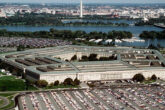April 19, 2022
The New Nuclear Age
In late June 2021, satellite images revealed that China was building 120 intercontinental ballistic missile (ICBM) silos on the edge of the Gobi Desert. This was followed by the revelation a few weeks later that another 110 missile silos were under construction in Hami, in Xinjiang Province. Together with other planned expansions, these sites amount to a dramatic shift in the country’s approach to nuclear weapons. For decades, China maintained a relatively small nuclear force, but according to current U.S. intelligence estimates, that arsenal is now on track to nearly quadruple, to 1,000 weapons, by 2030, a number that will put China far above any other nuclear power save Russia and the United States. Nor does it seem likely that Beijing will stop there, given President Xi Jinping’s commitment to build a “world class” military by 2049 and his refusal to enter into arms control talks.
It is hard to overstate the significance of this effort. In developing a nuclear arsenal that will soon rival those of Russia and the United States, China is not merely departing from its decades-old status as a minor nuclear state; it is also upending the bipolar nuclear power system. For the 73 years since the Soviet Union’s first nuclear test, that bipolar system, for all its flaws and moments of terror, has averted nuclear war. Now, by closing in on parity with the two existing great nuclear powers, China is heralding a paradigm shift to something much less stable: a tripolar nuclear system. In that world, there will be both a greater risk of a nuclear arms race and heightened incentives for states to resort to nuclear weapons in a crisis. With three competing great nuclear powers, many of the features that enhanced stability in the bipolar system will be rendered either moot or far less reliable.
In this precarious new strategic environment, it will be crucial for the United States to anticipate new challenges and respond to them nimbly.
There is nothing the United States can do to prevent China from joining it and Russia as the world’s top nuclear powers, but there are things that U.S. strategists and defense planners can do to mitigate the consequences. For starters, Washington will need to modernize its nuclear deterrent. But it will also need to engage in new ways of thinking about the nuclear balance of power and how, in a far more complex strategic environment, it can maintain deterrence and keep the nuclear peace.
Read the full article from Foreign Affairs.
More from CNAS
-
Lessons in Learning
Executive Summary Although claims of a revolution in military affairs may be overhyped, the potential for artificial intelligence (AI) and autonomy to change warfare is growin...
By Josh Wallin
-
The Pentagon Push to Change an “Antiquated” System
Carlton Haelig, a fellow at the Center for a New American Security, joined The Cipher Brief to discuss the systems in place in the Department of Defense and the challenges ass...
By Carlton Haelig
-
The Department of Defense’s Breakthrough Nuclear Moment Risks Slipping Away
Unless they act, the Department of Defense’s breakthrough nuclear moment may vanish before it really happens....
By Will Rogers
-
DEFAERO Strategy Series [Apr 09, 25] CNAS' Becca Wasser and Phil Sheers on Revitalizing the U.S. Defense Industrial Base
On this episode of the Defense & Aerospace Report Strategy Series, sponsored by General Atomics Aeronautical Systems, Becca Wasser and Phil Sheers of the Center for a New Amer...
By Becca Wasser & Philip Sheers




